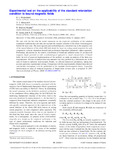
Please use this identifier to cite or link to this item:
http://ricaxcan.uaz.edu.mx/jspui/handle/20.500.11845/555| Title: | Experimental test on the applicability of the standard retardation condition to bound magnetic fields |
| Authors: | Kholmetskii, Alexander Missevitch, Oleg Smirnov Rueda, Roman Ivanov, Rumen Chubykalo, Andrew |
| Issue Date: | 31-Jan-2007 |
| Publisher: | American Institute of Physics |
| Abstract: | We start with the fact that the actual consensus on the empirical verification of the standard retardation condition does not take into account the complex structure of the whole electromagnetic field in the near zone. The most rigorous and methodologically consistent way to the empirical test of the causal behavior of the whole EM field should be based on testing causal properties for each component—velocity dependent bound and acceleration dependent radiation —taken separately. Preliminary discussions on the relative contribution of bound and radiation terms for an idealized magnetic dipole provided us with a methodological approach to causal characteristics of bound fields. In view of practical implementation of this method, we made an analysis of the finite size loop antennas. The use of multisection loop antennas was fully justified by a substantial rise of the ratio of bound-to-radiation field strength. Finally, we effected numerical calculations, taking into account particular experimental settings. Comparison with the experimentally obtained data showed considerable discrepancy with the predictions of the standard electromagnetic theory. A possible interpretation in terms of nonlocal properties of bound fields in near zone is proposed. |
| URI: | http://hdl.handle.net/20.500.11845/555 https://doi.org/10.48779/fzhq-qt65 |
| Other Identifiers: | info:eu-repo/semantics/publishedVersion |
| Appears in Collections: | *Documentos Académicos*-- UA Física |
Files in This Item:
| File | Description | Size | Format | |
|---|---|---|---|---|
| 2007-JApplPhys_101_023532.pdf | 359,28 kB | Adobe PDF |  View/Open |
This item is licensed under a Creative Commons License
